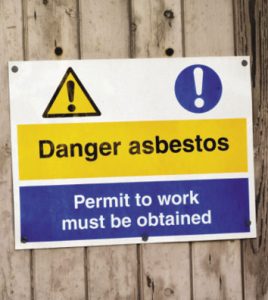 Kate Gardner, Health and Safety Trainer at International Workplace on the inquiry launched by the Government into why asbestos related disease is still the UK’s biggest occupational killer
Kate Gardner, Health and Safety Trainer at International Workplace on the inquiry launched by the Government into why asbestos related disease is still the UK’s biggest occupational killer
More than 5,000 deaths a year are recorded from diseases such as mesothelioma, lung cancer and asbestosis – all of which are due to exposure to asbestos.
Currently, the duty to manage asbestos is contained in Regulation 4 of the Control of Asbestos Regulations 2012 and requires the ‘duty-holder’ to:
- Take reasonable steps to find out if there are asbestos-containing materials (ACM) in non-domestic premises, and if so, its amount, where it is and what condition it is in.
- Presume materials contain asbestos unless there is strong evidence that they do not.
- Make, and keep up to date, a record of the location and condition of the ACM – or materials presumed to contain asbestos.
- Provide information on the location and condition of the materials to anyone who is liable to work on or disturb them.
GOVERNMENT INQUIRY
However, this might soon change as the Work and Pensions Committee recently launched an inquiry into how the HSE manages the continued presence of asbestos in buildings, following the publication of a report by think tank ResPublica.
The Committee’s inquiry and call for evidence will examine the current risks posed by asbestos in the workplace, the actions taken by the HSE to mitigate them, and how its approach compares to those taken in other countries.
Rt Hon Stephen Timms MP, Chair of the Work and Pensions Committee, said: “With the UK death rate from asbestos-related illness the highest in the world, there are serious concerns about how the material is being dealt with compared with how it is managed in other countries, such as France. The HSE is rightly looking into how asbestos can be handled more safely and the Committee’s inquiry will help to make sure monitoring and regulations are as effective and safe as they can possibly be.”
RECOMMENDATIONS
The report by ResPublica makes the following initial recommendations:
- The government should bring the health and safety regime for the management of asbestos up to the highest international standards.
- It should establish a central register of all asbestos currently in place in public buildings across the UK (including schools, hospitals and social housing).
- A cost-benefit analysis for the removal of all asbestos from public buildings in the UK needs to be commissioned.
- The HSE should revise the current ‘Duty to Manage’.
- The HSE should amend guidance and risk assessments to take account of early exposure, different levels of ‘in-situ’ risks, and the higher risks posed by Amosite and Crocidolite.
- The HSE should accurately measure and represent fatality figures and the actual harm caused by asbestos exposure.
- The HSE should assure (rather than assume) buildings are safe, through the requirement for periodic sensitive air monitoring based upon revised risk and priority assessment.
- The HSE should improve the regime for reporting the disturbance of asbestos materials.
- Research funding bodies in the UK should consider the current gaps in academic literature about the risk asbestos-containing materials pose in-situ.
The UK Asbestos Training Association (UKATA) has also raised concerns around the lack of asbestos training that has been undertaken since the start of the COVID-19 pandemic.
Said Craig Evans, Chief Operating Officer of UKATA: “Our concern is that the fabric of the many workplaces and public buildings that have been closed during the COVID-19 outbreak will have declined. The very people who manage the buildings may have been furloughed and therefore they will not have been inspected for deterioration of any asbestos present. This increases the risk of exposure to deadly asbestos fibres for the buildings’ users.”
Duty to Manage training is a legal requirement; however, industry figures show the number of workers who have undertaken asbestos training since March has steeply declined and is at its lowest level for five years.
ADVICE TO FMS
Changes to asbestos guidance and legislation are likely to have significant consequences for duty holders when managing asbestos on their premises. Greater regulation will mean organisations have to demonstrate they have done all that is ‘reasonably practicable’ to avert the risk of exposure to asbestos. Organisations do not have to cause actual harm in order to fall foul of health and safety legislation; the mere creation of a risk of harm is sufficient for enforcement action to be taken by the HSE. It’s therefore vital that building managers and appointed persons ensure that their asbestos training is up-to-date.
The tricky part is that asbestos-related diseases can take up to 40 years to manifest themselves and therefore it takes a long stretch of time before the asbestos bans start bearing fruit. The latency period of asbestos, coupled with a substantial drop in training, could mean that the UK faces a greater number of deaths from asbestos over the next 15-60 years. If you’re a long-running business, past employees could come back to you with claims of asbestos exposure from many years ago.





